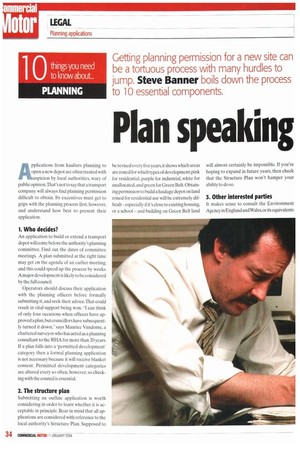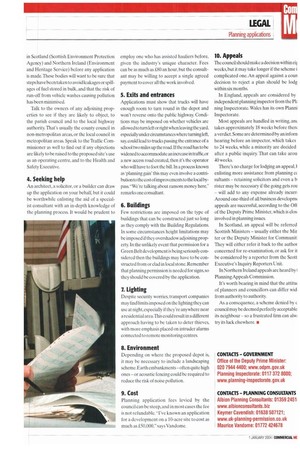Plan speaking
Page 34

Page 35

If you've noticed an error in this article please click here to report it so we can fix it.
Applicalions from hauliers planning to open a new depot are often treated with s uspicion by local authorities, wary of public opinion.That's not to say that a transport company will always find planning permission difficult to obtain. Its executives must get to grips with the planning process first, however, and understand how best to present their application.
1. Who decides?
An application to build or extend a transport depot will come before the authority's planning committee. Find out the dates of committee meetings. A plan submitted at the right time may get on the agenda of an earlier meeting, and this could speed up the process by weeks. A major development is likely to be considered by the. full council.
Operators should discuss their application with the planning officers before formally submitting it, and seek their advice. That could result in vital support being won. "I can think of only four occasions when officers have approved a plan, but councillors have subsequently turned it down," says Maurice Vandome, chartered surveyor who has acted as a planning consultant to the RHA for more than 20 years. If a plan falls into a 'permitted development' category then a formal planning application is not necessary because it will receive blanket consent. Permitted development categories are altered every so often, however, so checking with the council is essential.
2. The structure plan Submitting an outline application is worth considering in order to learn whether it is acceptable in principle. Bear in mind that all applications are considered with reference to the local authority's Structure Plan. Supposed to be revised every five years,it shows which areas are zoned for which types of development;pink for residential, purple for industrial, white for unallocated.and green for Green Belt, Obtaining permission to build a haulage depot on land zoned for residential use will be extremely difficult—especially if it's close to existing housing. or a school — and building on Green Belt land will almost certainly be impossible. If you're hoping to expand in future years, then check that the Structure Plan won't hamper your ability to do so.
3. Other interested parties It makes sense to consult the Environment Agency in England and Wales, or its equivalents in Scotland (Scottish Environment Protection Agency) and Northern Ireland (Environment and Heritage Service) before any application is made. These bodies will want to be sure that steps have been taken to avoid leakages or spillages of fuel stored in bulk, and that the risk of run-off from vehicle washes causing pollution has been minimised.
Talk to the owners of any adjoining properties to see if they are likely to object, to the parish council and to the local highway authority. That's usually the county council in non-metropolitan areas, or the local council in metropolitan areas. Speak to the Traffic Commissioner as well to find out if any objections are likely to be raised to the proposed site's use as an operating centre, and to the Health and Safety Executive.
4. Seeking help
An architect, a solicitor, or a builder can draw up the application on your behalf, but it could be worthwhile enlisting the aid of a specialist consultant with an in-depth knowledge of the planning process. It would be prudent to employ one who has assisted hauliers before, given the industry's unique character. Fees can be as much as £80 an hour. but the consultant may be willing to accept a single agreed payment to cover all the work involved.
5. Exits and entrances
Applications must show that trucks will have enough room to turn round in the depot and won't reverse onto the public highway. Conditions may be imposed on whether vehicles are allowed to turn left or right when leaving t he yard. especially under circumstances where turning left, say, could lead to trucks passing the entrance of a school two miles up the road. lithe road has to be widened to accommodate an increase in traffic,or a new access road created, then it's the operator who will have to foot the bill. In a process known as 'planning gain' this may even involve a contribution to the cost of improvements to the local bypass."We're talking about ransom money here," remarks one consultant.
G. Buildings
Few restrictions are imposed on the type of buildings that can be constructed just so long as they comply with the Building Regulations. In some circumstances height limitations may be imposed if they overshadow adjoi ning property in the unlikely event that permission for a Green Belt development is being seriously considered then the buildings may have to be constructed from or clad in local stone. Remember that planning permission is needed for signs, so they should be covered by the application.
7. Lighting
Despite security worries, transport companies may find limits imposed on the lighting they can use at night, especially if they're anywhere near a residential area.This could result ma different approach having to be taken to deter thieves, with more emphasis placed on intruder alarms connected to remote monitoring centres.
8. Environment
Depending on where the proposed depot is. it may be necessary to include a landscaping scheme. Earth embankments-often quite high ones or acoustic fencing could be required to reduce the risk of noise pollution.
9. Cost
Planning application fees levied by the council can be steep, and in most cases the fee is not refundable. -I've known an application for a development on a 10-acre site to cost as much as £50,000." says Vandome.
10. Appeals
The council should make a decision within eif weeks, but it may take longer if the scheme i complicated one. An appeal against a coun decision to reject a plan should be lodg within six months.
In England, appeals are considered by independent planning inspector from the Pk fling Inspectorate. Wales has its own Planni Inspectorate.
Most appeals are handled in writing. am takes approximately 18 weeks before then a verdict. Some are determined by an inforn hearing before an inspector, which takes to 24 weeks, while a minority are decided after a public inquiry. That can take arou 40 weeks.
There's no charge for lodging an appeal. I enlisting more assistance from planning suItants retaining solicitors and even a b rister may be necessary if the going gets rou will add to any expense already incur') Around one-third of all business developmi appeals are successful, according to the Off of the Deputy Prime Minister, which is clos involved in planning issues.
In Scotland. an appeal will be referred Scottish Ministers usually either the Mir ter or the Deputy Minister for Communiti They will either refer it back to the author concerned for re-examination, or ask for it be considered by a reporter from the Scott Executive's Inquiry Reporters Unit.
In Northern Ireland appeals are heard by I Planning Appeals Commission.
It's worth bearing in mind that the attitth of planners and councillors can differ wid from authority to authority As a consequence. a scheme denied by c council may be deemed perfectly acceptable its neighbour so a frustrated firm can ahm try its luck elsewhere. •












































































































































































